Essay: The Epidemiologic Approach in Disease Causation Notions
VerifiedAdded on 2020/03/13
|5
|927
|120
Essay
AI Summary
This essay delves into the epidemiologic approach as a method for understanding disease causation. It highlights the strengths of this approach, such as its ability to inform preventive actions and provide cost-effective and generalizable results, while also acknowledging its weaknesses, including the difficulty in controlling confounding factors and the limitations of observational studies. The essay further discusses the importance of epidemiology in the 21st century, emphasizing its role in studying disease-causing agents, informing health promotion programs, and evaluating health interventions. It references key literature and demonstrates the approach's contribution to scientific knowledge for disease prevention and public health decision-making.
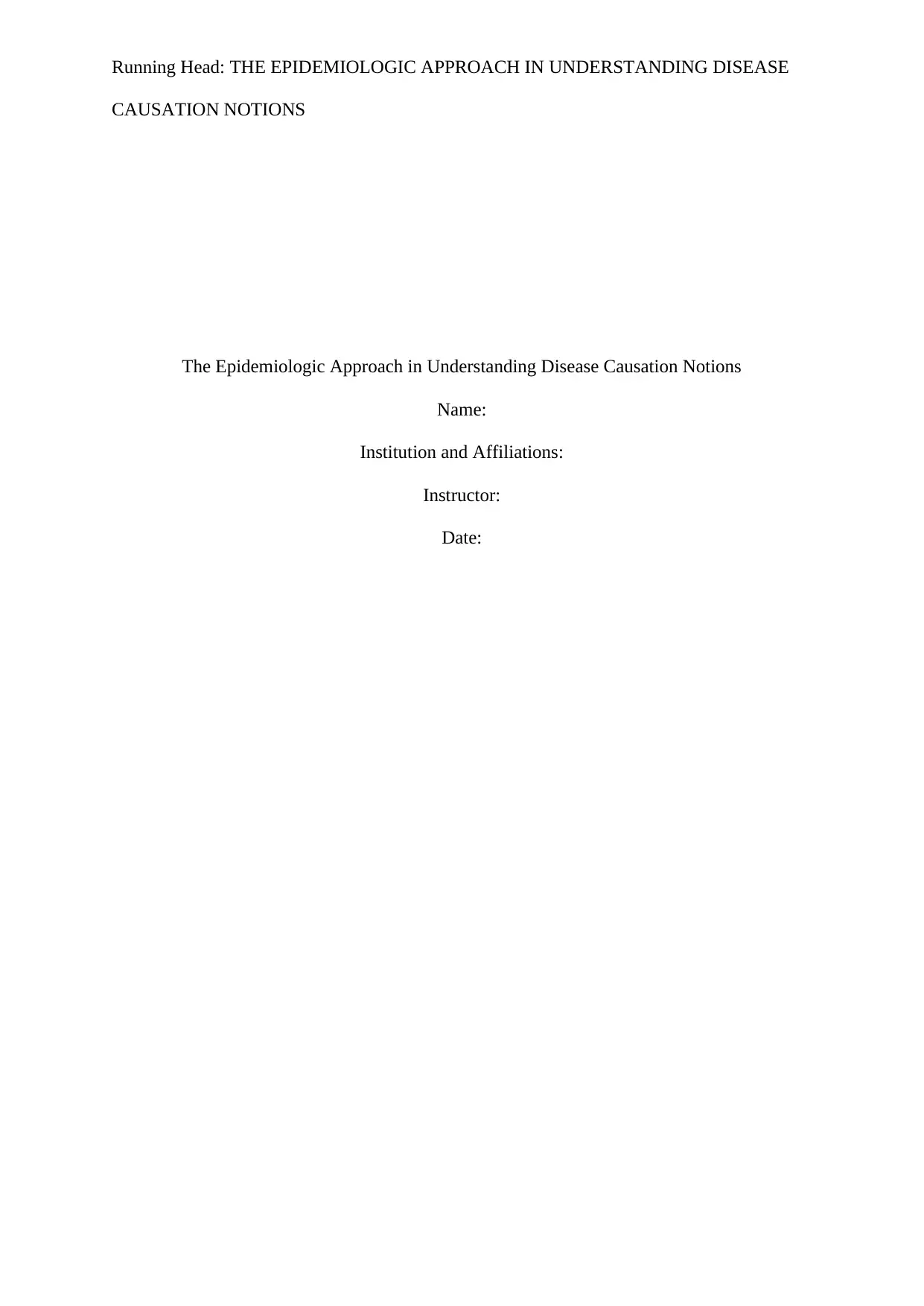
Running Head: THE EPIDEMIOLOGIC APPROACH IN UNDERSTANDING DISEASE
CAUSATION NOTIONS
The Epidemiologic Approach in Understanding Disease Causation Notions
Name:
Institution and Affiliations:
Instructor:
Date:
CAUSATION NOTIONS
The Epidemiologic Approach in Understanding Disease Causation Notions
Name:
Institution and Affiliations:
Instructor:
Date:
Paraphrase This Document
Need a fresh take? Get an instant paraphrase of this document with our AI Paraphraser
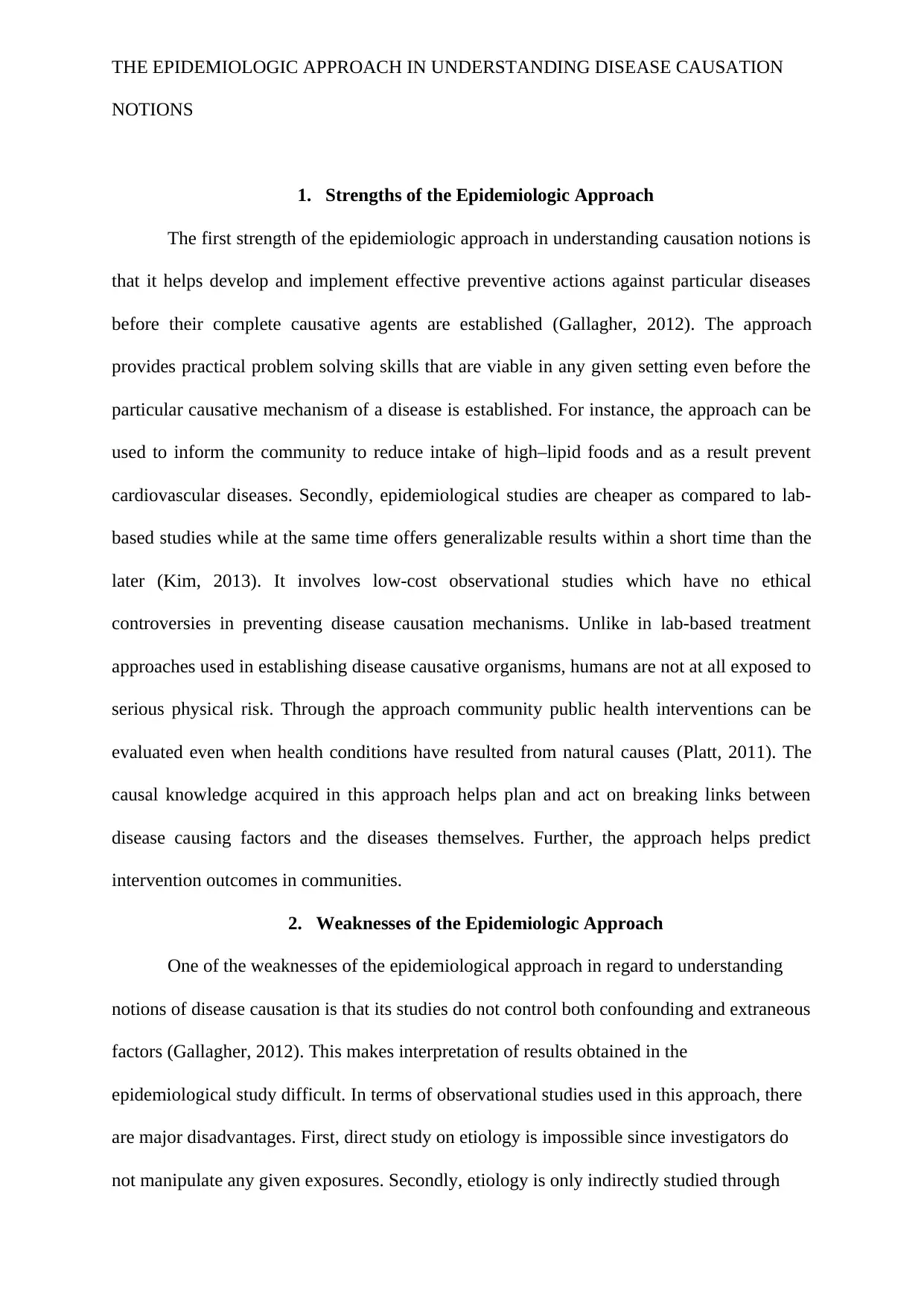
THE EPIDEMIOLOGIC APPROACH IN UNDERSTANDING DISEASE CAUSATION
NOTIONS
1. Strengths of the Epidemiologic Approach
The first strength of the epidemiologic approach in understanding causation notions is
that it helps develop and implement effective preventive actions against particular diseases
before their complete causative agents are established (Gallagher, 2012). The approach
provides practical problem solving skills that are viable in any given setting even before the
particular causative mechanism of a disease is established. For instance, the approach can be
used to inform the community to reduce intake of high–lipid foods and as a result prevent
cardiovascular diseases. Secondly, epidemiological studies are cheaper as compared to lab-
based studies while at the same time offers generalizable results within a short time than the
later (Kim, 2013). It involves low-cost observational studies which have no ethical
controversies in preventing disease causation mechanisms. Unlike in lab-based treatment
approaches used in establishing disease causative organisms, humans are not at all exposed to
serious physical risk. Through the approach community public health interventions can be
evaluated even when health conditions have resulted from natural causes (Platt, 2011). The
causal knowledge acquired in this approach helps plan and act on breaking links between
disease causing factors and the diseases themselves. Further, the approach helps predict
intervention outcomes in communities.
2. Weaknesses of the Epidemiologic Approach
One of the weaknesses of the epidemiological approach in regard to understanding
notions of disease causation is that its studies do not control both confounding and extraneous
factors (Gallagher, 2012). This makes interpretation of results obtained in the
epidemiological study difficult. In terms of observational studies used in this approach, there
are major disadvantages. First, direct study on etiology is impossible since investigators do
not manipulate any given exposures. Secondly, etiology is only indirectly studied through
NOTIONS
1. Strengths of the Epidemiologic Approach
The first strength of the epidemiologic approach in understanding causation notions is
that it helps develop and implement effective preventive actions against particular diseases
before their complete causative agents are established (Gallagher, 2012). The approach
provides practical problem solving skills that are viable in any given setting even before the
particular causative mechanism of a disease is established. For instance, the approach can be
used to inform the community to reduce intake of high–lipid foods and as a result prevent
cardiovascular diseases. Secondly, epidemiological studies are cheaper as compared to lab-
based studies while at the same time offers generalizable results within a short time than the
later (Kim, 2013). It involves low-cost observational studies which have no ethical
controversies in preventing disease causation mechanisms. Unlike in lab-based treatment
approaches used in establishing disease causative organisms, humans are not at all exposed to
serious physical risk. Through the approach community public health interventions can be
evaluated even when health conditions have resulted from natural causes (Platt, 2011). The
causal knowledge acquired in this approach helps plan and act on breaking links between
disease causing factors and the diseases themselves. Further, the approach helps predict
intervention outcomes in communities.
2. Weaknesses of the Epidemiologic Approach
One of the weaknesses of the epidemiological approach in regard to understanding
notions of disease causation is that its studies do not control both confounding and extraneous
factors (Gallagher, 2012). This makes interpretation of results obtained in the
epidemiological study difficult. In terms of observational studies used in this approach, there
are major disadvantages. First, direct study on etiology is impossible since investigators do
not manipulate any given exposures. Secondly, etiology is only indirectly studied through
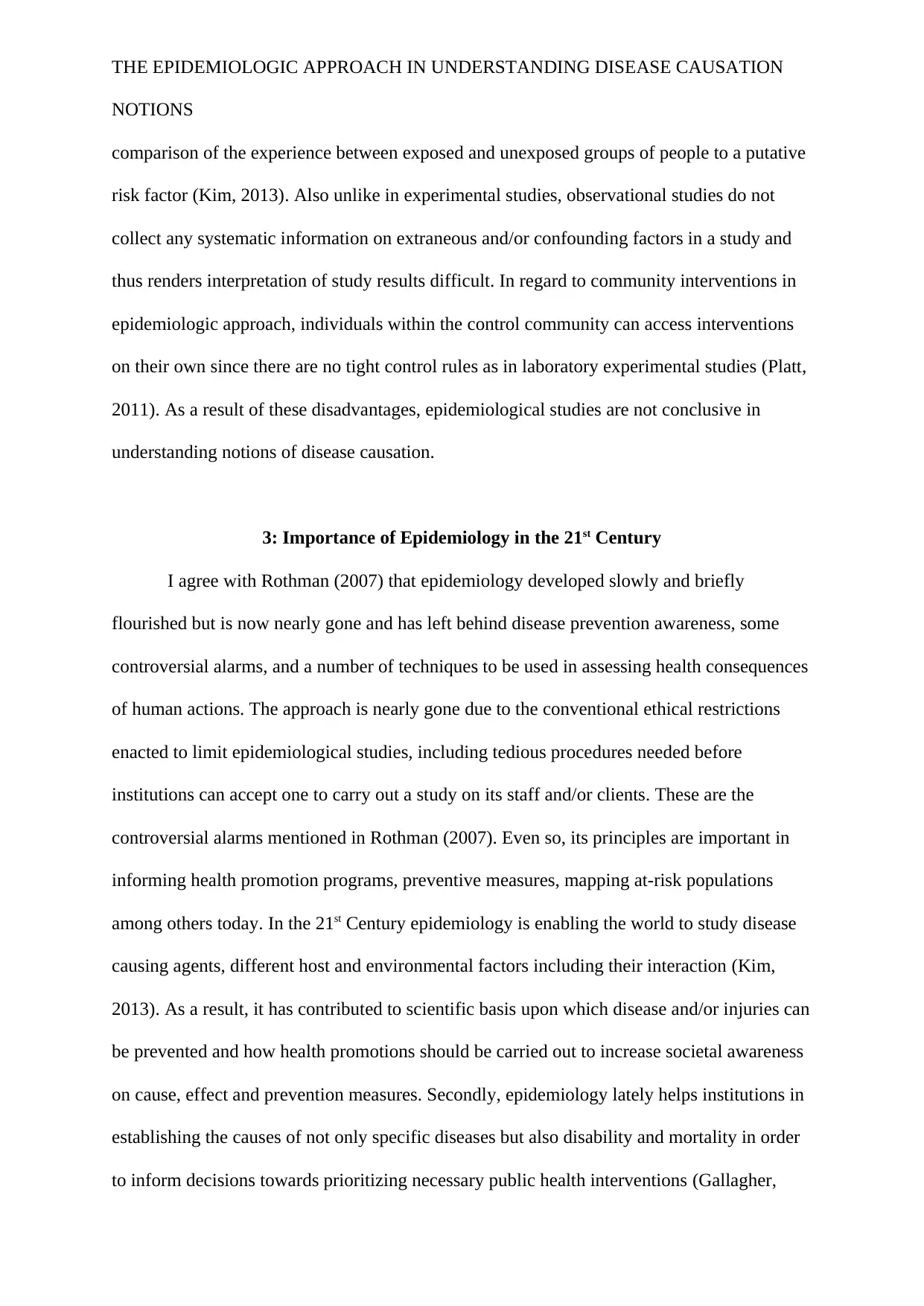
THE EPIDEMIOLOGIC APPROACH IN UNDERSTANDING DISEASE CAUSATION
NOTIONS
comparison of the experience between exposed and unexposed groups of people to a putative
risk factor (Kim, 2013). Also unlike in experimental studies, observational studies do not
collect any systematic information on extraneous and/or confounding factors in a study and
thus renders interpretation of study results difficult. In regard to community interventions in
epidemiologic approach, individuals within the control community can access interventions
on their own since there are no tight control rules as in laboratory experimental studies (Platt,
2011). As a result of these disadvantages, epidemiological studies are not conclusive in
understanding notions of disease causation.
3: Importance of Epidemiology in the 21st Century
I agree with Rothman (2007) that epidemiology developed slowly and briefly
flourished but is now nearly gone and has left behind disease prevention awareness, some
controversial alarms, and a number of techniques to be used in assessing health consequences
of human actions. The approach is nearly gone due to the conventional ethical restrictions
enacted to limit epidemiological studies, including tedious procedures needed before
institutions can accept one to carry out a study on its staff and/or clients. These are the
controversial alarms mentioned in Rothman (2007). Even so, its principles are important in
informing health promotion programs, preventive measures, mapping at-risk populations
among others today. In the 21st Century epidemiology is enabling the world to study disease
causing agents, different host and environmental factors including their interaction (Kim,
2013). As a result, it has contributed to scientific basis upon which disease and/or injuries can
be prevented and how health promotions should be carried out to increase societal awareness
on cause, effect and prevention measures. Secondly, epidemiology lately helps institutions in
establishing the causes of not only specific diseases but also disability and mortality in order
to inform decisions towards prioritizing necessary public health interventions (Gallagher,
NOTIONS
comparison of the experience between exposed and unexposed groups of people to a putative
risk factor (Kim, 2013). Also unlike in experimental studies, observational studies do not
collect any systematic information on extraneous and/or confounding factors in a study and
thus renders interpretation of study results difficult. In regard to community interventions in
epidemiologic approach, individuals within the control community can access interventions
on their own since there are no tight control rules as in laboratory experimental studies (Platt,
2011). As a result of these disadvantages, epidemiological studies are not conclusive in
understanding notions of disease causation.
3: Importance of Epidemiology in the 21st Century
I agree with Rothman (2007) that epidemiology developed slowly and briefly
flourished but is now nearly gone and has left behind disease prevention awareness, some
controversial alarms, and a number of techniques to be used in assessing health consequences
of human actions. The approach is nearly gone due to the conventional ethical restrictions
enacted to limit epidemiological studies, including tedious procedures needed before
institutions can accept one to carry out a study on its staff and/or clients. These are the
controversial alarms mentioned in Rothman (2007). Even so, its principles are important in
informing health promotion programs, preventive measures, mapping at-risk populations
among others today. In the 21st Century epidemiology is enabling the world to study disease
causing agents, different host and environmental factors including their interaction (Kim,
2013). As a result, it has contributed to scientific basis upon which disease and/or injuries can
be prevented and how health promotions should be carried out to increase societal awareness
on cause, effect and prevention measures. Secondly, epidemiology lately helps institutions in
establishing the causes of not only specific diseases but also disability and mortality in order
to inform decisions towards prioritizing necessary public health interventions (Gallagher,
⊘ This is a preview!⊘
Do you want full access?
Subscribe today to unlock all pages.

Trusted by 1+ million students worldwide
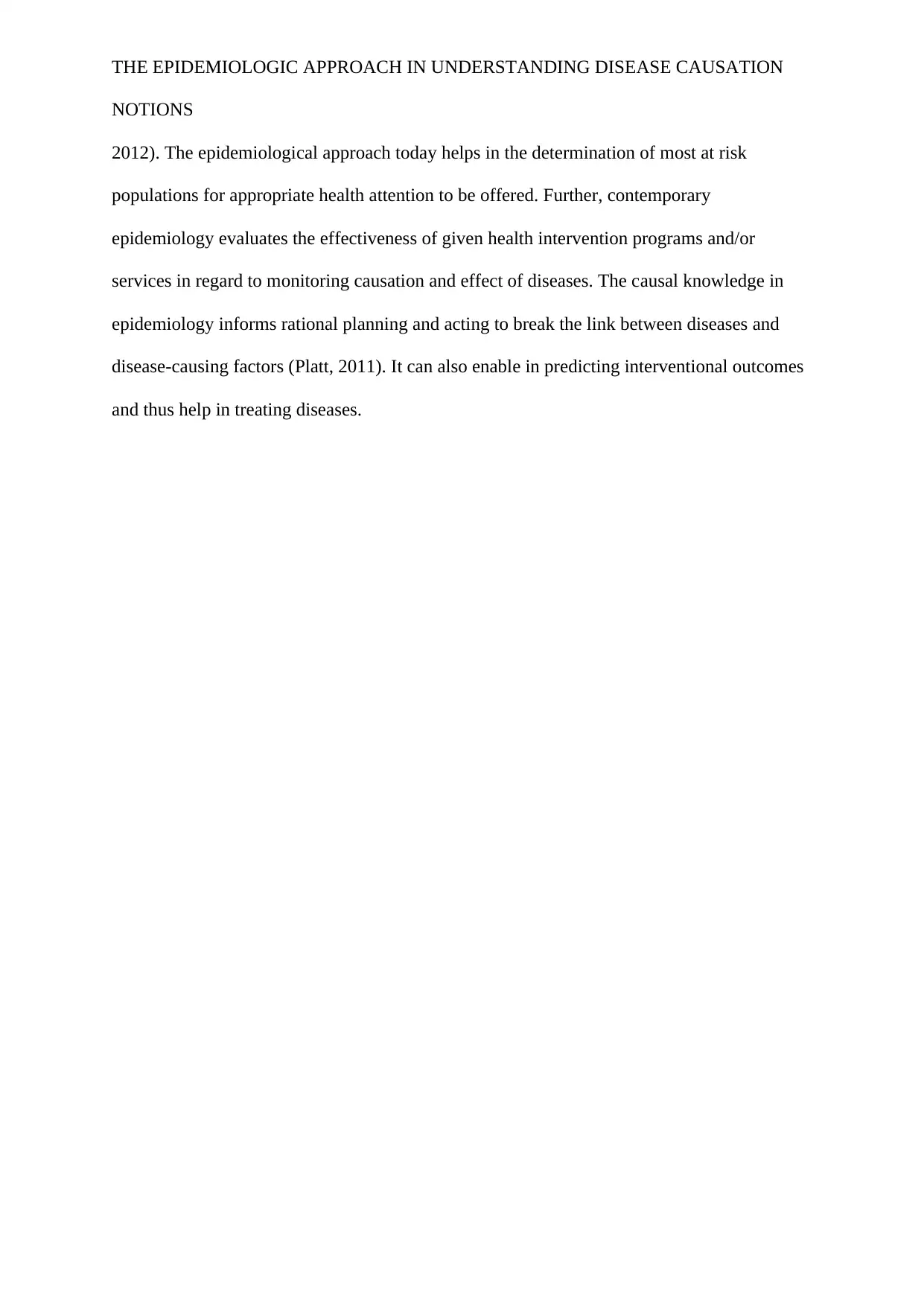
THE EPIDEMIOLOGIC APPROACH IN UNDERSTANDING DISEASE CAUSATION
NOTIONS
2012). The epidemiological approach today helps in the determination of most at risk
populations for appropriate health attention to be offered. Further, contemporary
epidemiology evaluates the effectiveness of given health intervention programs and/or
services in regard to monitoring causation and effect of diseases. The causal knowledge in
epidemiology informs rational planning and acting to break the link between diseases and
disease-causing factors (Platt, 2011). It can also enable in predicting interventional outcomes
and thus help in treating diseases.
NOTIONS
2012). The epidemiological approach today helps in the determination of most at risk
populations for appropriate health attention to be offered. Further, contemporary
epidemiology evaluates the effectiveness of given health intervention programs and/or
services in regard to monitoring causation and effect of diseases. The causal knowledge in
epidemiology informs rational planning and acting to break the link between diseases and
disease-causing factors (Platt, 2011). It can also enable in predicting interventional outcomes
and thus help in treating diseases.
Paraphrase This Document
Need a fresh take? Get an instant paraphrase of this document with our AI Paraphraser
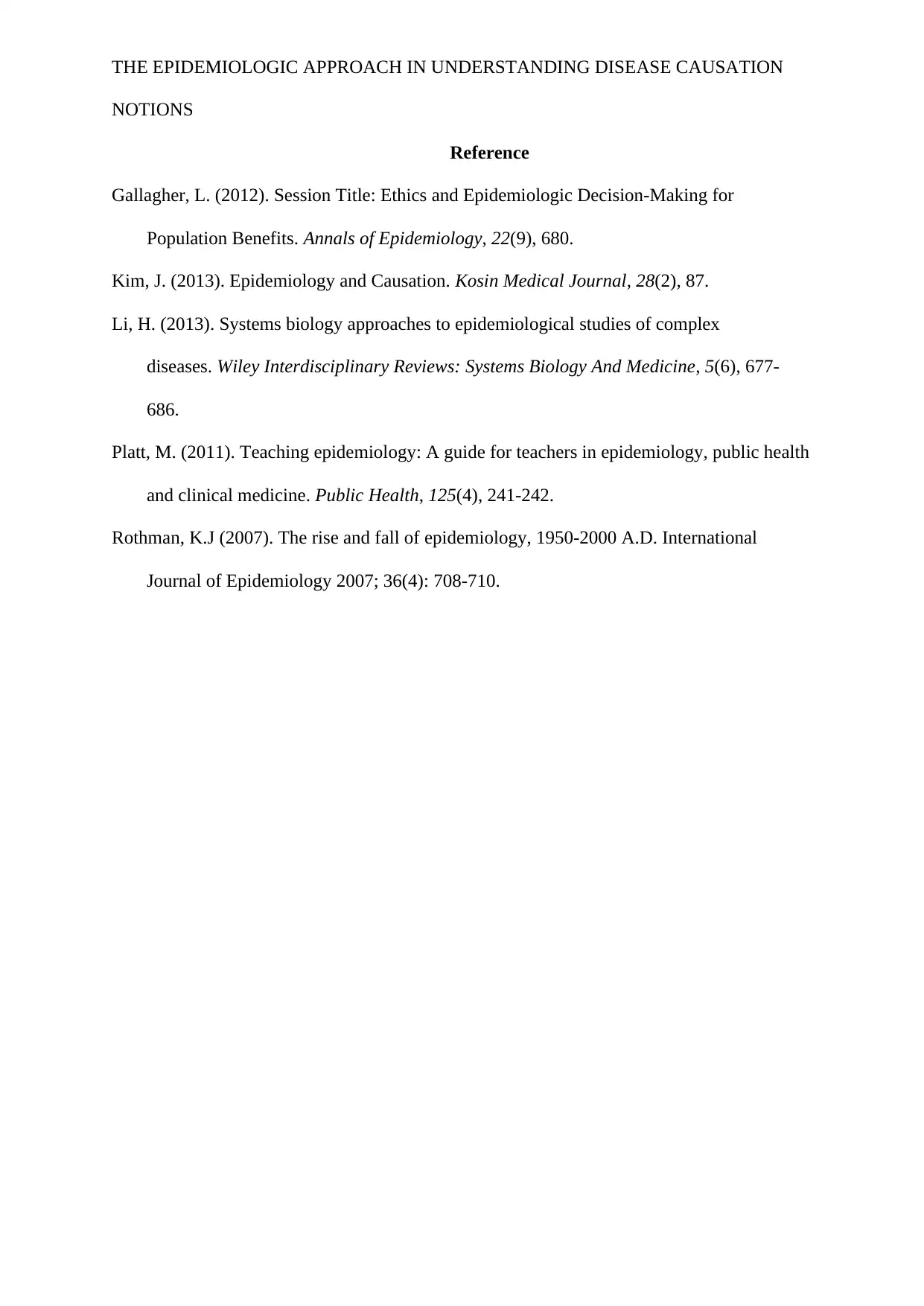
THE EPIDEMIOLOGIC APPROACH IN UNDERSTANDING DISEASE CAUSATION
NOTIONS
Reference
Gallagher, L. (2012). Session Title: Ethics and Epidemiologic Decision-Making for
Population Benefits. Annals of Epidemiology, 22(9), 680.
Kim, J. (2013). Epidemiology and Causation. Kosin Medical Journal, 28(2), 87.
Li, H. (2013). Systems biology approaches to epidemiological studies of complex
diseases. Wiley Interdisciplinary Reviews: Systems Biology And Medicine, 5(6), 677-
686.
Platt, M. (2011). Teaching epidemiology: A guide for teachers in epidemiology, public health
and clinical medicine. Public Health, 125(4), 241-242.
Rothman, K.J (2007). The rise and fall of epidemiology, 1950-2000 A.D. International
Journal of Epidemiology 2007; 36(4): 708-710.
NOTIONS
Reference
Gallagher, L. (2012). Session Title: Ethics and Epidemiologic Decision-Making for
Population Benefits. Annals of Epidemiology, 22(9), 680.
Kim, J. (2013). Epidemiology and Causation. Kosin Medical Journal, 28(2), 87.
Li, H. (2013). Systems biology approaches to epidemiological studies of complex
diseases. Wiley Interdisciplinary Reviews: Systems Biology And Medicine, 5(6), 677-
686.
Platt, M. (2011). Teaching epidemiology: A guide for teachers in epidemiology, public health
and clinical medicine. Public Health, 125(4), 241-242.
Rothman, K.J (2007). The rise and fall of epidemiology, 1950-2000 A.D. International
Journal of Epidemiology 2007; 36(4): 708-710.
1 out of 5
Your All-in-One AI-Powered Toolkit for Academic Success.
+13062052269
info@desklib.com
Available 24*7 on WhatsApp / Email
![[object Object]](/_next/static/media/star-bottom.7253800d.svg)
Unlock your academic potential
Copyright © 2020–2025 A2Z Services. All Rights Reserved. Developed and managed by ZUCOL.

